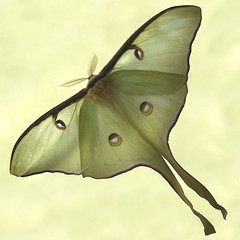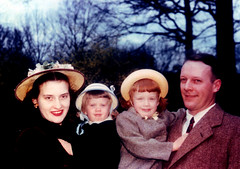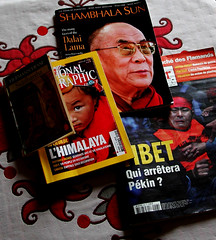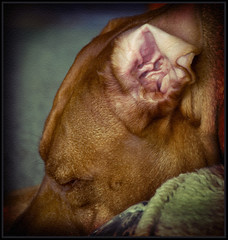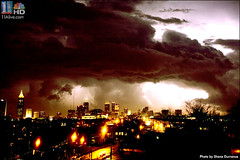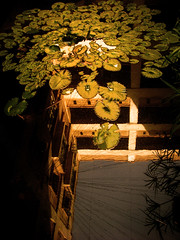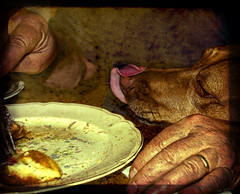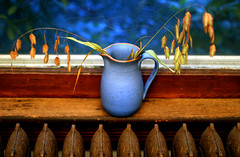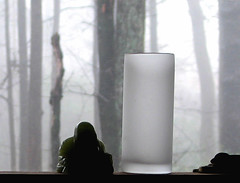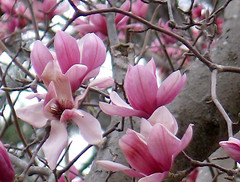Two white, a blue, and brown
one day I’ll forget the combination
exchange the brown for blue.
Even now my mind becomes confused.
I do not know that it matters.
A blue pill
A brown pill, the white
I am reminded of a painting
a white bird in a bubble
floating under a petal by the rocks
Layer within layer
Always something
until Silence insists on Nothing
taking my medicine.
P Bralley.
Sunday, March 30, 2008
One Day
Friday, March 28, 2008
News in Brief
Check it out.
And enjoy yourself.
Wednesday, March 26, 2008
Pain-Body (Part Four): Remembering Winter
It merges with past pain and lodges in your mind and body.
This accumulated pain is a negative energy field, and if you look upon it as an invisible entity in its own right, you are getting quite close to the truth…
The pain-body usually has a collective as well as a personal aspect…
The collective one is the pain accumulated in the collective human psyche over thousands of years through disease, torture, war, murder, cruelty, madness…
Eckhart Tolle
My question is, “How is this possible?”
How is it possible to inherit what’s essentially a memory?
That should be impossible.
I should not actually “remember” what happened to my grandmother.
Yet, Tolle says we bear the scars and thus is some sense the memory.
Years ago my brother told me of a study in which mice were put on a zinc deficient diet. Their descendents had depressed immune systems for the next five generations – even when zinc was restored to normal levels.
To Andy, these results not only showed the importance of proper nutrition
but also had implications for all of us today.
Since there has probably never been a time when five generations have all received adequate nutrition, we must all still bear the marks of our ancestors’ deprivation.
Five generations.
That takes us back to great-great grandfathers.
In my case, these are the Bralley and Kearfotts who fought the Civil War.
In my case, when Andy mentioned the nutrition research, I was plagued by "flashback" of wars I hadn’t been alive to see.
So, I liked the idea of trans-generational memory even if it was just nutritional.
But then, it hit me.
“That is Lamarkism. And, That Can’t Be!”
Darwin shot that all to pieces.
“Acquired traits” like memories or nutritional status cannot be inherited,
and pain-bodies should not be possible.
Yes, I know. There is Nurture as well as Nature.
Psychological damage does get passed from one generation to the next.
But, Tolle seems to be describing something physical, something sounding almost genetic.
He is talking Nature.
So let’s lay aside for the moment the psychological impact our parents’ traumas.
Let’s also set aside the possibility that information may be “immaterial” - encoded “in our souls.”
Are there still factors creating an inheritable pain-body?
“Every emotional pain that you experience leaves behind a residue of pain”
I think this is what Tolle’s saying. There is something physical that gets created and inherited.
Which brings me back to, “How can this be?”
Maharishi, called it stress:
an emotional overload that changes our physiology and bodies.
Marahishi said that stress creates a knot. (A knot of what he did not say.)
Now we know that Post Traumatic Stress Disorder affects the hippocampus (seat of memory) and HPA axis (hypothalamus, pituitary, adrenal axis - brain signals breaking out into the entire body).
PTSD also gives you flashbacks as memory replays in waking nightmares.
…But, how…
How could the traumatic memory be passed on to future generations?
How could I know what it was like to be a soldier in a war I never fought?
I could I develop PTSD from a war I was never in? (which is one way of describing my struggles for over twenty years after I awakened in 1975.)
I have mulled these questions over for several decades now.
It was only last month that I came across a journal article on plants entitled:
Remembering winter: toward a molecular understanding of vernalization.
Oh!
If plants “remember winter” then surely brains are not required.
But, of course! This is exactly the point in the PTSD refrain, “the body remembers.”
The article on plants went something along these lines:
Exposure to the cold of winter is an important cue for flowering in spring.
Flowering is due to cold-mediated modifications of proteins in the chromatin…
This process is known as vernalization…
which is just the technical way of saying plants recall the cold by modifying the proteins that entwine their DNA.
Memories don’t always require a brain.
And molecular information is not solely stored in the genes (which is the Darwinian position and the geneticist’s and my prejudice).
Information can be stored “epigenetically.”
Remember that word.
Epigenetics makes it possible to inherit acquired traits
(like the depressed immune systems of mice on low zinc diets.)
Epigenetics makes it possible to remember winter
(like a rose covered by the snow.)
Epigenetics can be trans-generational.
Epigenetics puts an end to protests of “Lamarkism!”
Epigenetics explains how “memory” can be inherited.
For Example:
Swedish men born in 1905 who experienced famine just before puberty, had grandsons who went through puberty earlier and had lengthened life spans.
Grandsons of the well fed had shortened life spans and increased diabetes.
For Example:
The World War II food embargo imposed by Germany on Holland caused 30,000 deaths.
The descendents of survivors suffered a range of health problems inlcuding: diabetes, obesity, coronary heart disease, cancer, as well as smaller-than-normal grandchildren.
Our bodies can remember that grandmother nearly starved.
Not That I have Proved a Thing
It’s no where close to really nailing down Tolle’s statements about the pain-body.
But, it puts us in the ball park.
One - Memory need not be confined simply to the brain. The body can remember.
Two - The impact of events (call it memory for short) can be inherited.
I find all of this exciting, even radical.
Radical? You say.
Yes!
And germane to those interested in understanding the mechanics of spiritual cultivation and enlightenment.
Realizing who you are is a piece of cake compared to living it.
It is a freebie.
You don’t have to do a thing for it, you don’t have to change, and you don’t have to alter anything…
Just relax and do nothing, go nowhere, and be nobody just for a split second – and grace shows you who you are …
When you want to live this awakening, you realize it will cost you.
The cost is your fixated point of view…
The cost is your resentment, blame, and judgment.
Adyashanti
The cost is the dissolution of your pain-body.
And that is something that you have to work at.
This is how we let go of all fixated views and ego.
So best we understand what the pain-body is, how it is created,
and what dissolving feels like.
Let me say this in another way:
For the past one hundred years biologists have held the view that as a caterpillar changes into a butterfly or moth, it essentially dissolves into a soup.
In its new incarnation the butterfly not only has an entirely different body, but also a whole new lifestyle, diet, and ecological niche.
Recently however, scientists have shown that a moth can remember what it learned as a caterpillar.
To be specific: Shock a caterpillar when it smells a certain chemical and later the moth will avoid that odor.
The moth can recall its conditioning- what it learned essentially in its “previous life” as “worm.”
Perhaps this learning/memory is stored in small pieces of neurocircuitry that remain intact in the soup. There are hints of this, but even so, it is a radical concept that old memory circuits survive the dissolution and are then re-integrated in the new nervous system.
This is so radical an idea that I am tempted to wonder that perhaps even caterpillars have a “soul” - something that records life lessons, not unlike the brain-dead subjects mentioned in Allan Hamilton’s book, The Scalpel and the Soul.
So, do butterflies have pain-bodies?
Do butterflies have flashbacks?
My god, the humiliation of remembering that once you were a worm!
Spiritual evolution can be ruthless in its search for truth.
Are butterflies not even spared?
I can empathize, as I recall the time in the fourth grade when I was forbidden to take recess with the other children.
My penmanship was so terrible that my teacher insisted I stay at my desk carefully writing out over and over again:
The worm one of the lowest forms of animals crawls on its belly.
“May I go to recess now?”
“No!”
Obviously, it was a lesson on “w,” “l” and “m”
I, however, took it as an opportunity to create one more bit of personal pain-body.
Which may, or may not, inspire a reinterpretation of this classic lesson:
The great Taoist master Chuang Tzu once dreamt that he was a butterfly fluttering here and there.
In the dream he had no awareness of his individuality as a person.
He was only a butterfly.
Suddenly, he awoke and found himself laying there, a person once again.
But then he thought to himself, "Was I before a man who dreamt about being a butterfly, or am I now a butterfly who dreams about being a man?"
(Any explanations will be welcomed.)
Monday, March 24, 2008
The Scalpel and the Soul
I have been working for sometime very carefully on a post that is about the pain body and memory without nervous systems ... and getting rather tangled up in the details.
Meanwhile, I happened to visit Dean Radin's blog (Entangled Mines) "just now"... Do you ever go there? I have the link - interesting fellow.
Anyway, he provided yet another link to a neurosurgeon who has written a book, The Scalpel and the Soul.
Trust me. Go there and listen to this man's video!
He's done a much better job than I will ever do with pain body and memory.
And now, I feel as if I am smiling into the camera, holding up my tube of tooth paste for all to see, "Buy some today."
"You'll be glad you did."
No more blogs on the fly? Vote here, under comments.
Sunday, March 23, 2008
Loss and Resurrection: Happy Easter, 2008.
First, a burglar too not only all of our electronics, but also my jewelry box.
That box contained an assortment of little presents Pop had given me.
Mostly they were items I never ever wore because they were “all wrong:”
A pair of shiny redwood pins shaped into “PB.” (Would an 9 year old wear those?)
A silver, turquoise and coral inlaid Zuni Indian dancing with a black obsidian snake gripped between his teeth that I simply found grotesque.
A string on large agate beads, never formally strung. (Great for a matronly neck, but I was 15 at the time.)
An antique black opal ring from Italy – which I thought beautiful, but after I’d destroyed Grandma’s garnet ring (my one inheritance from her) in about a week’s time, I hesitated
to wear anything of real value.
Maybe it wasn’t so much a jewelry box as it was a haven for each somewhat “unfortunate” object, every one of which precious by the simple fact it came straight from Pop’s love.
I hardly ever wore them. But from time to time, I’d sit with them. I’d turn each one carefully, ponder each, and remember.
That was gone, now – forever.
No more holding. No more touching.
We moved on to planning Pop’s Memorial.
I wanted to use some of the Dixieland music that he loved.
He had had a large collection of records carefully transferred to reel-to-reel tape.
Poppy loved a party and he taught us all about good true jazz, and just how to rattle the bones, which he could do two handed.
He filled our house with Dixieland and celebration.
play Alphonse Picou and High Society.
This particular rendition was perfection, to me “a classic” that embodied both joy and heart break.
Well, Mom had warned me, but I hadn’t believed her.
I was welcome to have a look, but the tape recordings had disappeared years ago.
The records had been ruined more recently in a flood from the garage, though she still had a box or two.
My hopes crumbled along with one after another of the album covers.
I managed to salvage a couple records, but
I still ended up in tears, kneeling there amidst the hopeless decay.
No more listening. No more singing along.
No more High Society. No more Alphonse Picou.
But, this is an Easter message.
And my theme this past week has been something about redeeming what is lost, and the growing realization that we are all in this together.
So, voila! ...
Surprise, delight, and joy – I have found Alphonse Picou on YouTube.
Here’s a clip from around 1959 from the last years of his life.
Alphonse Picou plays his clarinet solo in High Society.
The tempo seems a bit slower than I recall.
The video is low resolution.
But, you still hear that potent mix of joy and pathos that slay me as a kid.
Viewed 10,754 times and counting in the last year.
Alphonse Picou and his music are not lost.
Here’s for you, Mom.
And for you, Pop.
For big sister Sandy and little brother Andy.
And for all of you “out there” … Happy Easter.
Friday, March 21, 2008
Tibetan Culture
Nathaneal and I share an interest in calligraphy... and now, I find, Tibet and the Dalai Lama.
I wanted to draw your attention to his suggestion that we educate ourselves about the Tibetan culture. What a good suggestion and positive action.
Sadly too, his image and suggestion brought to mind the situation in Ray Bradbury's novel, Fahrenheit 451. Faced with a society that banned and burned all books, people saved them by committing them to memory...
Taking them to heart.
Seems we are being called to many lessons: non-violence, diversity, and love.
Thank you, Nathanael.
Non-violence and the Small Voice of Truth
Did you listen?
You didn’t know that was the wisdom of the universe, did you?
You didn’t know that was the enlightened Buddha nature (prajna) giving you a gift of grace, right?
The beauty of truth is that truth never insists.
The truth that comes to you from the inside is known, but does not insist.
This is why it can be thrown away so easily and effortlessly.
You don’t have to listen to it.
Adyashanti
You don’t have to listen, because Love is patient and this Truth speaks of the eternal.
Yesterday, I asked how it could possibly be that the non-violence of the Dalai Lama could ever win out over the guns and tanks of Chinese brutality.
Here-in lies the answer: The Dalai Lama is following the small voice of the truth that never insists, the wisdom of the Universe.
Because of this, Truth is irresistible in its non-resistance.
This Truth expresses itself through all the laws of Nature.
And Nature dwarfs anything that man can come up with.
Nuclear Winter? The Universe says, “Alright.”
Let’s have 10,000 years without sunshine and then gradually a new balance will arise. Yang will come from Yin… invariably, in time.
The Universe doesn’t insist that we master our lessons at any particular pace, in any particular manner.
Seems to me it just nudges us along, setting up the consequence, which is actually the counter-balance to whatever choice we make.
Adya puts a sign on the door of his retreats: “Resistance is Futile.”
It prompts an explanation once again, so perhaps this time we’ll get it.
“That which we resist persists.”
We draw to us that which we push away.
I was in a taxi once, on the back roads of India, when the driver suddenly pulled over and announced he was stopping for a rest.
There was a tree, a shack, and a yard of grassless dirt - hardly an oasis – but then, this country that was showing me bone crushing poverty. This land had had the life sucked from its soil to an extent I had never seen.
I didn’t want to stop.
The shack was dark, the whole place, suspect.
I didn’t want beggars coming up to me, as they inevitably would, the moment I got out of the car.
I wasn’t leaving my protection, the means of my escape.
I folded my arms and grimaced silently to Becky, “Don’t leave me here alone.”
She jumped out with the driver eager to have a look-see.
They enjoyed a cold soda, a little chit-chat, and good leg stretch before
returning to the car,
which to my utter horror had become engulfed - windows, hood, windshield – by small children pressing against every inch of glass.
Hugh brown eyes and soft red lips were eagerly chanting a surreal lesson, “Pen? Pen? Pen?”
Sometimes, the Universe isn’t the least bit subtle in its delivery.
After what seemed an eternity, Becky climbed back in and started laughing.
The driver took us to our destination… an ashram where we hoped to find the Avatar.
And I now think the car ride was every bit as enlightening as our planned itinerary.
“Accept everything, as if you had requested it,” is how Eckhart Tolle puts it.
Adya has redressed any misconceptions, “Accepting does mean condone.”
And neither does Non-violence…
Accepting means you do not resist that which the Universe presents to you.
This is what you get. Now embrace it.
It’s a subtle, high stakes teaching.
I think it takes a Buddha or a Dalai Lama to really live it well.
I think this is our invitation from the Universe.
Thursday, March 20, 2008
The Dalai Lama and Peace

Dalai Lama in Chile
Originally uploaded by Gabriel Ortega Berger
The Dalai Lama has his own web pages here at Emory University.
A few years ago he spoke at graduation.
Last October, he came for several days to accept a professorship.
The Drepung Loseling Monastery’s North American seat is an affiliate of Emory University and here in Atlanta.
So, I was not surprised when I received this email yesterday:
At 5 pm today through Friday on the Quad, Tibetan monks will be holding prayer vigils for peace and for their fellow monks in Tibet during this turbulent time.
This past week Tibetan monks and citizens protested the continuing oppressive rule China holds over Tibetan religious rights. The demonstrations quickly escalated as Chinese military police quelled the protesters. Violence ensued. Some reports claim 80 Tibetans died in the turmoil.
Each vigil will last about 20 minutes. All are invited to attend, observe, and respectfully offer support. Thank you!
No, I was not surprised. I turned and looked out my window at the steady rain, the cold gray day, and was sad.
I pictured the monks in their bright ochre robes, standing with bowed heads, and a wet dispirited turn-out of a few students.
I forwarded the email to a friend with the comment that it made me sad.
Morning Edition, March 18, 2008:
The Dalai Lama made a startling threat Tuesday, saying he would step down as the leader of a Tibetan government in exile if protesters in Tibet continued their violent protests.
Later, one of his top aides clarified the Dalai Lama's comments…
Tenzin Taklha said, "He would resign as the political leader and head of state, but not as the Dalai Lama. He will always be the Dalai Lama."
I had heard this sound bite as I did my morning asanas.
The Dalai Lama would step down? How could that be?
And then those words, almost sounding childlike in the trust they held, “He will always be the Dalai Lama.”
Of course! The Dalai Lama is too sweet to be other than who and what he is… at least to me.
Then this morning, as once again I did my asanas, came the next sound bite:
Morning Edition, March 20, 2008:
Chinese officials are ignoring calls for a dialog with protesters in Tibet.
Instead, they have labeled the Dalai Lama a "wolf in monk's clothes" and a "monster with a human face and an animal's heart."
Monster, wolf, animal?
How long does it takes for non-violence to win out?
How can it ever be?
It seems almost a logical impossibility.
And yet, sometimes it does.
My friend emailed me back today.
She had heard from a friend she trusted.
He added this bit of news and a suggestion:
Dear Friends,
On a personal note, my daughter Julie is married to a Tibetan refugee and is now living in Dharmsala, India, residence of the Dalai Lama.
In a call two days ago, she told me that they are getting what seems to be reliable information through family networks about Chinese atrocities that are far worse than what is being reported in the media.
I encourage you to sign this petition and share it with others.
Thanks.
There was this logic offered:
China does care about its international reputation.
Its economy is totally dependent on "Made in China" exports …
it is keen to make the Olympics in Beijing this summer a celebration of a new China…
So, I signed.
And I am sharing the petition.
They hope to raise a million voices in unison for peace.
Wednesday, March 19, 2008
Stroke of Insight
It seems that I can actually perceive how information brought in through my eyes is processed by the brain in a stepwise manner.
You’re not supposed to be able to do this:
i.e. “observe the brain from the inside,” as neuroanatomist, Jill Bolte Taylor has said.
But, Dr Taylor has done exactly this, while having a stroke,
when she was 37 and a researcher at Harvard.
Her “stroke of insight” she calls it.
In neurophysiology way back when, I was taught that every sense discards information as it collects input from the world.
The signals that do get through to the brain are then integrated together, step after step, layer after layer, by the sensory cortex.
Beyond the step of collecting light, there are the next tasks:
images are constructed, images are interpreted,
interpretation is linked with memory and the greater context.
It seems that with my migraines, a layer of this processing simply drops out.
And “seeing” no longer works the way it use to.
Seeing no longer feels like seeing.
Seeing doesn’t make the sense it should.
(Senses should make sense? Oh! I would demand that, yes.)
And I am left pawing at my face to remove glasses that I am not wearing, as I scream inside, “I cannot see!”
All this is by way of an introduction to a talk by Jill Bolte Taylor at a recent TED Conference.
She tells quite a moving story… for a scientist and mystic.
And just so you won’t miss it, I excerpt here a comment left by Saeed Dyanatkar in the TED Comments Section:
This is not the first time a scientist is talking the same way as a mystic.
In Persian literature there is a famous story about an occasion in which a mystic (Abu Saeed Abel-kheir) met a scientist (ave Sina) and after a very long exchange of ideas they conclude their experiences for their students:
Ave-Sina: Whatever I know he sees.
Abel-Kheir: Whatever I see he knows.
Smaller than the Smallest, Larger than the Largest
Jill Bolte Taylor’s talk brought to mind a phrase Maharish was quite fond of:
Knowledge is structured in Consciousness.
(i.e. what you know depends upon whether you are asleep or awake or dreaming, your state of consciousness.)
And there is a corollary:
Every state of consciousness is supported by a unique physiology.
(i.e. observe the body’s behavior during waking, sleeping, and dreaming states. Or view the physiological parameters elegantly diagramed by dream researcher, J. Allan Hobson.)
By contrast, Adyashanti chooses to emphasize a very different point.
Adya says enlightenment is not a state of consciousness.
Which I think is his way of emphasizing that the Consciousness experienced in Enlightenment is the Pure Consciousness of Non-Changing and Ever-Present Wholeness.
Pure Consciousness is not generated by the brain.
Pure Consciousness is the ground, the clay – from which the universe, all brains and all brain-states arise.
(And, personally, given as I am to physiology, I still think one of these brain-states supports the behavior we think of as “enlightened.” That is to say, a specific brain state supports Consciousness becoming conscious.)
It is all very circular -
like some kind of möbius strip, or better yet
M.C. Escher’s, “Drawing Hands.”
Maharishi used to tell us,
The range of Creative Intelligence (Consciousness) is from smaller than the smallest to larger than the largest.
As I tried to understand this - just what could be smaller than the smallest
and also larger than the largest -
I used to contemplate a hierarchy of academic disciplines that ran something along these lines:
When describing the smallest things
quantum physics begins with the vacuum and QED (quantum electro-dynamics)
which is the basis of all chemistry
which is the basis of all biology
which leads to needing sociology
and geology for studies of the World
which leads to planets and astronomy
which leads to galaxies and spiral nebulae, space-time and gravity,
and of course the big-bang (where everything comes out of nothing)
which must be understood in terms of astrophysics
which loops us back to QED and the vacuum.
Can you picture what this means?
I could never quite swallow that the vacuum was actually Pure Consciousness.
But years later when I re-read my notes I found that Maharishi believed they were identical.
So yesterday, I went looking one more time.
I found these words online, those of a physicist, regarding QED:
To be sure, we are electromagnetic creatures in an electromagnetic world, existing at the intersection between light and electricity.
If you haven’t done so already, do listen to Jill Bolte Taylor’s talk at the TED conference.
You’ll find this is pretty much what she discovered for her self.
What I Slept Through
I have a sleepy little photo from my bathroom window earlier in the evening. I liked the sunset and the street lights and the fog.
Later as I went to sleep, I was enjoying the lightening as Bennie slowly turned his head looking at the window a bit concerned.
"It's all right," patting his head, in my wisdom I tried to reassure him. I chuckled at his disbelief and went to sleep.
Meanwhile - 8 miles away - kind of looks like the end of the world. And someone is out a quarter of a billion dollars.
Monday, March 17, 2008
Monet Refuses The Operation
by Lisel Mueller
Doctor, you say there are no haloes
around the streetlights in Paris
and what I see is an aberration
caused by old age, an affliction.
I tell you it has taken me all my life
to arrive at the vision of gas lamps as angels,
to soften and blur and finally banish
the edges you regret I don't see,
to learn that the line I called the horizon
does not exist and sky and water,
so long apart, are the same state of being.
Fifty-four years before I could see
Rouen cathedral is built
of parallel shafts of sun,
and now you want to restore
my youthful errors: fixed
notions of top and bottom,
the illusion of three-dimensional space,
wisteria separate
from the bridge it covers.
What can I say to convince you
the Houses of Parliament dissolves
night after night to become
the fluid dream of the Thames?
I will not return to a universe
of objects that don't know each other,
as if islands were not the lost children
of one great continent. The world
is flux, and light becomes what it touches,
becomes water, lilies on water,
above and below water,
becomes lilac and mauve and yellow
and white and cerulean lamps,
small fists passing sunlight
so quickly to one another
that it would take long, streaming hair
inside my brush to catch it.
To paint the speed of light!
Our weighted shapes, these verticals,
burn to mix with air
and change our bones, skin, clothes
to gases. Doctor,
if only you could see
how heaven pulls earth into its arms
and how infinitely the heart expands
to claim this world, blue vapor without end.
Mueller has herself gone blind.
She knows.
And I bow my head and cry.
She knows.
A Poem A Day
As usual she lifts my spirit. Please visit her website to read her full essay and other pieces.
For January she says:
“Honour the fate you are”…
I don’t want it to sound like I believe in pre-destination – fate is never that, but it is the web of possibilities from which we unthread our particular journey.
It may be that we don’t honour ourselves enough – in the sense of respecting our real nature – actual and developing.
The business of trying to be ourselves is a full-time occupation – which is not to say give up your job and your family, but is to say don’t be troubled by the size of the task.
Individuality is not a small thing.
I have said many times that I believe poetry can make a huge difference to how we feel about ourselves and about ourselves in the world.
I have just been reading The Letters of Ted Hughes, really engaging stuff,
and well worth getting hold of.
He says somewhere what I have found for myself, that reading poetry out loud is revelatory.
It is in part the incantation, which is ancient and mystical,
something we used to do, and rarely do now.
It is in part the sound and feel of breath, your breath mingling with the breath of the poet.
It is in part recitation, the pleasure of pushing the thing out of your body at the same time as taking it into the body.
I find that if I recite something a few times, I can learn it without really trying – though I know this happens through habit, and won’t happen to someone straightaway.
But it will fend off memory loss, and it will give you something to play with in your head the next time you are stuck on a tube-train, or in a queue, or any other situation that requires personal resources, great or small.
In any case, poetry is such an antidote to babble
that a dose of it once a day reminds us what language is – and what it isn’t.
Try it for the New Year – a poem every day read outloud... Think of it as a stretch exercise.
Inspired, I went looking for a poem and found none that really suited…
End of blog.
Until today.
Love Like Salt
It lies in our hands in crystals
too intricate to decipher
It goes into the skillet
without being given a second thought
It spills on the floor so fine
we step all over it
We carry a pinch behind each eyeball
It breaks out on our foreheads
We store it inside our bodies
in secret wineskins
At supper, we pass it around the table
talking of holidays and the sea.
Lisel Mueller
Thursday, March 13, 2008
Tikkun Olam and Obama
There is a magazine by this name, the voice the of the “Tikkun community” which is composed of people of many faiths.
Editor Rabbi Michael Lerner has an article in this month’s issue entitled, “The Obama Phenomenon.”
To entice you to read it in it’s entirety, I have excerpted a portion here:
…this editorial is not about Obama as much as about what he elicits in others, and should not be read as an endorsement of him.
The energy, hopefulness, and excitement that manifests in Obama’s campaign has shown up before in the last fifty years…
It was there in the 1960s and 1970s in the Civil Rights movement, the anti-war movement, the women’s movement, the environmental movement, and the movement for gay liberation.
One felt it flowing at rallies and demonstrations at which Robert Kennedy, Cesar Chavez, Betty Friedan, Isaac Deutscher, Joan Baez, and Martin Luther King, Jr. articulated their visions.
It was there again in Earth Day, in the anti-nuclear movement, and in the movement against the war with the Contras.
It was there during the campaign of Jesse Jackson in 1988 and the Clintons’ campaign in 1992. And it has been there—dare we say it—in the growth of the religious right and the Campus Crusade for Christ.
What is that energy and excitement, and why does it touch people so deeply?...
The phenomenon in question is this:
the intense desire of every human being on this planet to overcome and transcend
the materialism and selfishness that shape the global economic arrangements
and permeate the consciousness of all people,
to overcome the looking-out-for-number one consciousness that divides us…
and to overcome the alienation from each other that this way of being has created
so that we might once again recognize each other as embodiments of God or Spirit…
We Avert Our Eyes from One Another
Every gesture, every word, every deed …
every message we give ourselves
all combine to either reinforce our separation and estrangement from each other
or to reconnect us in a deep way that allows genuine mutual recognition,
the seeing and hearing of who we really are,
the contact we have with the sacred in ourselves, in each other, and in the world.
Recently, some columnists have compared Obama to a rock star because his supporters seem to treat him more like that than like a politician.
They are only partially mistaken.
What the best and most fulfilling rock concerts of the past several decades have offered one generation is what other multi-generational mega-churches or Super Bowls and World Series’ offer to others:
a chance to momentarily experience a transcendence of all those feelings of loneliness and alienation…
The Effectiveness of Not Demonizing
Obama’s appeal starts from his insistence on not demonizing the Other…
Obama knows that most people want a very different world,
but don’t believe it is possible unless someone else makes it happen.
He challenges his audience by telling them that there is no one else,
that they themselves are the people who must make the world different.
To quote Obama from his Super Tuesday speech:
So many of us have been waiting so long for the time when we could finally expect more from our politics, when we could give more of ourselves and feel truly invested in something bigger than a particular candidate or cause.
This is it.
We are the ones we’ve been waiting for.
We are the change that we seek.
This is About Us, Not About Obama
…no matter how spiritually and emotionally dead the majority of people on the planet may appear to be,
no matter how lost in their pursuit of money and fame and sexual conquest and me-first-ism and don’t-bother-me-ism,
the truth is that the resurrection of the dead is always at hand, always a possibility.
Human beings can always be awakened again to choose life,
to choose love,
to choose kindness, generosity, ecological sensitivity, and awe and wonder at the grandeur of creation.
That capacity of human beings is what it means to have a soul…
I hope you take the time to read more of this essay. (I left out some interesting details.)
Wednesday, March 12, 2008
Worth Visiting
You may or may not have noticed that I recently added a link to The Cassandra Pages. I go there regularly for a bit of upliftment, inspiration, to visit with friends whom I have never met... and simply to be in a warm, good place and discover like (and more talented) minds.
Beth today has posted an item on a dolphin saving some beached whales. Not, her usual fare. But, it deeply moved me.
I have been enjoying her series about her 96 year old father-in-law. One day it will be a book, The Fig and the Orchid. In the meantime, how wonderful to see life unfold in real-time.
(However, if you go to this link be warned, scroll to the bottom and read up ... the real-time nature of blogs makes you read them in reverse. It's a very obvious and very curious phenomenon to me, strangely twisted, Escher-like.)
Saturday, March 08, 2008
HAPPY BIRTHDAY!!!
Someone I love turns 50 today... you know who you are!
In lieu of a celebration, enjoy this wonderful world redo.
Presents comes later! And cake, later! And hugs, later!
Love, Patty
Friday, March 07, 2008
A Blessing for Equilibrium
When I first opened my eyes this morning I was shocked to discover I had overslept by an entire hour on a workday.
I closed my eyes again.
And listened to the rain.
Was it on time or had it arrived early? I couldn’t recall the forecast, so I let that question slide.
And listened to the rain.
“I’m just going to be late.”
I reached a hand out to Bennie who was still sound asleep his own self.
“Why is this dog oversleeping too?” though he did stretch and roll over on his back when he felt my touch. Delicious.
Apparently, he was opting for more sleep.
We had both had troubled nights. He’d had a choking reverse breathing episode.
I had had a troubled dream and then slept sitting-up in hopes that an incipient migraine would clear up on its own.
No migraine now, just the quiet rain,
and the missing hour.
“OK, Bennie, we’ve got to get up now.”
Well, he thought that was a great idea.
It meant breakfast, which he calls “dinner,” and I debated the wisdom of my nomenclature as I watched him clear off the bed.
It meant a chew and harassing the cat.
Yeah, Bennie was all for getting up.
I was still ambivalent.
I hobbled slowly on feet swollen from poor circulation and numbed by deadened nerves,
straight to the coffee pot.
“I’m just going to be late.”
And the time passed, kind of in these half hour increments of tasks,
feeling relaxed almost like a weekend,
until eventually I found myself rinsing off the dishes in the kitchen sink.
I’d just called out, “SQUIRREL!”
which sent Bennie whirling out through his doggie door, the chase totally engaged,
squirrels scattering in all directions, Bennie boinging straight into the air like some spring lamb, as Louis Armstrong quietly intoned, “what a wonderful world,”
when I heard from deep inside, not so much precise words,
but the gentle Irish burr and rhythmic lapping
of this blessing by John O’Donohue.
And I knew I’d have to share it with you. Notice that if you are the least bit hurried as you read, the rhythm gets messed up. This blessing almost insists that one slow down.
A BLESSING FOR EQUILIBRIUM
from ‘Benedictus – A Book of Blessings’
Like the joy of the sea coming home to shore,
May the music of laughter break through your soul.
As the wind wants to make everything dance,
May your gravity be lightened by grace.
Like the freedom of the monastery bell,
May clarity of mind make your eyes smile.
As water takes whatever shape it is in,
So free may you be about who you become.
As silence smiles on the other side of what’s said,
May a sense of irony give you perspective.
As time remains free of all that it frames,
May fear or worry never put you in chains.
May your prayer of listening deepen enough
To hear in the distance the laughter of God.
Thursday, March 06, 2008
Reservations
Reservations? I have lots of Reservations!
Woody Woodpecker to Wally Walrus in the 1944 classic, “Ski for Two.”
That’s how you know your false self.
Adyashanti to a student at Omega, 2007.
This past summer at the Omega retreat, a woman explored with Adyashanti, her doubting nature. She had had an insight and was then immediately consumed and frustrated by her self doubts.
Below is Adya’s reply, as best I could distill it, from their dialog. For a smoother presentation I have left out the ellipsis:
That’s how you know your false self.
It’s how you protect yourself from the Void, tread water on the Void.
Anything, to not just stop and sink.
Everybody has their own way of treading water.
The direct route would be to look at who doubts.
Who is this that doubts?
Is there a doubter?
So much of what is going on inside of us is just an evasion tactic.
Anything, to distract them from the task at hand.
And Doubt is a wonderful distractor.
Ramana Maharishi use to say, “Doubt is the last thing to go.”
Have you ever noticed doubt never doubts itself?
Doubt everything but the doubter.
Why are you so certain of the doubt?
Dought has it’s own certainty. Right?
When I say, “What do you know for certain?” It’s not meant to actually find something. It’s meant to destroy what we don’t know for certain.
So an insight you may have about something, you don’t need to come to a certainty about it.
Just let go….
If there is a path at all, the path is undoing, undoing, undoing.
Unlearning, unlearning, unlearning.
Unknowing, unknowing, unknowing.
Adyashanti
Or, alternatively – forget the treading water, fly over the frozen stuff and set it all to music.
I see...
Reservations? ...(me or Woody, who knows)
“You’ve got to have a reservation!” (Wally Walrus)
Well, this is America!
All of this is implanted deep inside our brains.
And that’s both good news and bad… or neither. Depending on your reservations.
Enjoy yourself.
(Adya says repeatedly)
Monday, March 03, 2008
Clown Buddha
That is our persona, our personality structures, and all the rest.
And the real question, spiritually speaking, is
"What is peering through?"
Adyashanti
These past two weekends I have attended workshops with my Taoist Teacher, Wong Loh Sin See.
Each workshop has reminded me of Adyashanti’s teaching about the Clown Buddha,
a small drawing that he carries with him to all the retreats he leads.
Fortunately, I have found a copy of the Clown online, so I can share it with you here.
Adya explains the import of the image this way in The Five Truths:
A Zen guy said a great thing once about the Truth,
“It’s no more for being manifest as Buddha and It’s no less for being manifest as a human.” …
The Buddha is meditating -
and that Clown (that’s you and me by the way) that’s about as good as we ever get.
And it sees it’s true reflection that’s the Buddha Nature, the Pure Formless.
And that’s what we see in the Realization,
“Oh, my God, I am what I was chasing. I am the Buddha.”
But, just as important as this realization is this [other] realization.
‘Cause the Buddha Nature in you, when it wakes up,
What is it looking at? …
Buddha Nature is looking at the Clown…
And so Buddha Nature gets to have an opportunity to have a realization himself…
And the more deeply that [realization] dawns, you feel a seamlessness.
It’s not a sense of personal human perfection,
because what is that after all except for how someone defines it…
And even though in one sense there’s this beautiful pristine eternal gaze, inside…
there’s a seamlessness right into this Clown-like Nature: me-ness where there is no real me.
Another telling of the Cosmic Joke!
And, from where I sit, such very hopeful news.
I take it as an invitation to be kinder and more loving to ourselves.
Another invitation to Make Peace, Make Peace.
My last blog, about John O’Donohue, was inspired by a program called Speaking of Faith.
They used Irish music to create mood and deliver message.
One song in particular, On Taobh Tuathail Amach, seemed positively African in its wild drumming.
But, it was Irish and I didn’t understand a single syllable of the Gaelic.
This morning I found a translation.
On Taobh Tuathail Amach means, “From the Inside Out.”
Oh, what perfect timing!
Just as Buddha Nature may be surprised to see a Clown,
so the words of On Taobh Tauthail Amach surprised me.
The music has such a rambunctiousness, but the song is about making peace.
And the words seem so apropos this lesson of the Clown Buddha,
It starts almost with an invocation:
From the inside out
I don't want to fight again
From the inside out
(Then here’s the part I love)
I have fought with myself
Fought with God
Fought with my life
Fought with herself
Fought with my senses
Fought with himself
Fought so often
That I frightened myself
Don't make me fight again
It does me no good
Don't make me fight again
I don't want to misguide my soul…
You can hear the entire song on YouTube.
Or, visit Speaking of Faith (this seems a softer version, but you have to search a bit).
Sunday, March 02, 2008
John O’Donohue, Soul Friend
Sunday morning once again found me on my yoga mat and listening to the NPR program, Speaking of Faith.
Before too long, I stopped my stretching and lay back down in bed with Bennie. Rubbing his ears, entwining my fingers in his fur, I listened to the radio.
They talked of beauty and revealed beauty until the tears streamed down my face.
It is strange to be here.
The mystery never leaves you alone.
Behind your image, below your words, above your thoughts,
the silence of another world waits.
A world lives within you.
No one else can bring you news of this inner world.
Through the opening of the mouth, we bring out sounds from the mountain beneath the soul.
These sounds are words….
the uttering of the word reveals how each of us relentlessly creates.
Everyone is an artist.
Each person brings sound out of silence and coaxes the invisible to become visible.
John O’Donohue, Anam Cara
Irish poet and philosopher John O'Donohue was beloved for his book Anam Cara, Gaelic for "soul friend," and for his insistence on beauty as a human calling and a defining aspect of God.
Your identity is not equivalent to your biography.
There is a place in you where you have never been wounded, where there's a seamlessness in you, and where there is a confidence and tranquility in you,
and I think the intention of prayer and spirituality and love is now and again to visit that inner kind of sanctuary. …
Though the human body is born complete in one moment, the birth of the human heart is an on going process.
It is being birthed in every experience of your life.
Everything that happens to you has the potential to deepen you…
Patrick Kavanagh captures this sense of the benediction of happening:
“Praise, praise, praise/The way it happened and the way it is.”
Anam Cara
John O'Donohue died in his sleep this January at the age of 52.
His final work will be published posthumously, this month.
It's entitled, To Bless the Space Between Us: A Book of Blessings.
Beannacht, is one of his poems of blessing, which he wrote for his mother after his father's death. “Beannacht” is the Gaelic word for blessing.
On the day when
the weight deadens
on your shoulders
and you stumble,
may the clay dance
to balance you.
And when your eyes
freeze behind
the grey window
and the ghost of loss
gets in to you,
may a flock of colours,
indigo, red, green,
and azure blue
come to awaken in you
a meadow of delight.
When the canvas frays
in the currach of thought
and a stain of ocean
blackens beneath you,
may there come across the waters
a path of yellow moonlight
to bring you safely home.
May the nourishment of the earth be yours,
may the clarity of light be yours,
may the fluency of the ocean be yours,
may the protection of the ancestors be yours.
And so may a slow
wind work these words
of love around you,
an invisible cloak
to mind your life.
You can hear John O’Donohue recite Bennacht aloud.



